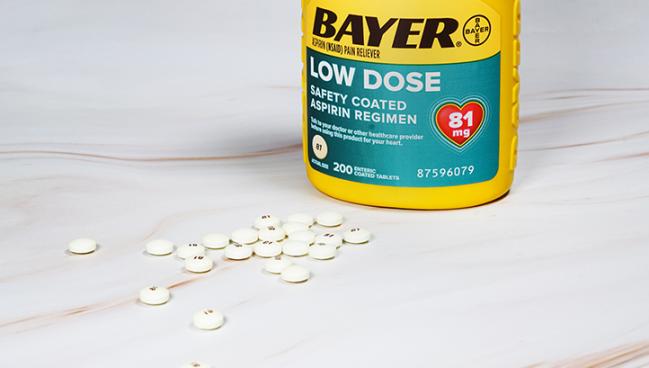Similar Outcomes With Enteric-Coated and Uncoated Aspirin: ADAPTABLE
The coating didn’t appear to diminish GI bleeding but, in better news, also didn’t dampen aspirin’s antiplatelet effects.

Opting for enteric-coated aspirin over the uncoated pills doesn’t appear to have a major impact on the drug’s antiplatelet effects in patients with atherosclerotic CVD, but nor did it offer an edge in terms of bleeding, according to a post hoc analysis of the ADAPTABLE trial.
Risk of a composite of MI, stroke, or all-cause death, and of major bleeding, did not differ based on the formulation chosen by patients at baseline, researchers led by Amber Sleem, DO (Ochsner Medical Center, New Orleans, LA), report in a paper published online this week in JAMA Cardiology.
Moreover, the presence of a coating didn’t significantly interact with the impact of using a higher versus lower dose of aspirin; the main results of ADAPTABLE showed that a 325-mg daily aspirin dose was no different than an 81-mg daily dose for major bleeding, or for MI, stroke, or all-cause death.
Earlier studies have suggested that enteric coating might reduce the risk of GI bleeding with aspirin, whereas others indicated that it might dampen the antiplatelet effects by impeding dissolution of the tablet and absorption of the drug, explained study author Mark Effron, MD (John Ochsner Heart and Vascular Institute, New Orleans, LA).
This study “is another step towards answering the question, saying that there is not a significant difference” between the two formulations, Effron said, noting, however, that there are some limitations of the analysis. It was not preplanned as part of the main trial, patients were not randomized by aspirin type, and use of enteric-coated or uncoated tablets was assessed only at the beginning of the study and could have changed during follow-up.
Still, Effron said, “I think, overall, that the data are fairly strong showing that there isn’t much of a difference.”
Secondary Analysis of ADAPTABLE
The investigators explored the question using the ADAPTABLE trial, which included 15,076 patients with atherosclerotic CVD who had data in the National Patient-Centered Clinical Research Network.
This post hoc analysis included 10,678 participants (median age 68 years; 68.2% men) who had information on the type of aspirin they were taking at baseline available. Overall, 69% were taking an enteric-coated form, with the rest taking uncoated tablets.
The primary effectiveness endpoint in this analysis was the same as in the overall trial (MI, stroke, or all-cause death), and through a median follow-up of 26.2 months, there was no difference between the enteric-coated and uncoated aspirin groups (adjusted HR 0.94; 95% CI 0.80-1.09).
Similarly, there was no difference in major bleeding events (adjusted HR 0.82; 95% CI 0.49-1.37), “although the 95% CI was wide, so that a reduction in bleeding with enteric-coated aspirin cannot be reliably excluded,” the authors write.
It doesn’t really matter what kind of aspirin they’re giving their patient as long as they’re giving them aspirin. Mark Effron
Aspirin type did not significantly interact with the impact of using a higher versus lower dose of aspirin in the trial, for either effectiveness (P = 0.41 for interaction) or safety (P = 0.07 for interaction. Among the patients taking enteric-coated tablets, however, there was a hint that the higher dose was associated with more major bleeding (0.7% vs 0.5%; adjusted HR 2.37; 95% CI 1.02-5.50).
Effron, however, said he wouldn’t put too much weight into that finding, citing the observational nature of the analysis and the small absolute difference observed.
Choosing a Formulation
Commenting for TCTMD, Dave Dixon, PharmD (Virginia Commonwealth University, Richmond), a member of the American College of Cardiology’s Prevention of Cardiovascular Disease Council, said this analysis doesn’t provide a definitive answer on the impact of enteric-coated versus uncoated aspirin, but rather “adds to the ongoing question of whether or not there’s truly a difference.”
He said it’s difficult to draw conclusions from what is essentially an observational study with potential confounders and other limitations despite the use of data from an RCT.
To the question of which formulation is better, Dixon said that in the presence of mixed data, “I generally really prefer that patients use the uncoated aspirin” and follow standard recommendations for taking the drug (ie, after a meal, particularly at night for those likely to have GI issues in the morning). Moreover, “if someone was having what they thought might be a heart attack and if they were going to take aspirin, we would still want them to use the uncoated aspirin” because it will be absorbed more rapidly, he said.
He noted, too, that low-dose aspirin, which is generally much better tolerated than higher doses, is what is used mostly in current practice anyway.
“I think it’s ideal to try and utilize the uncoated aspirin initially, and certainly if a patient is taking it with food and doing everything they can and if there’s still issues, then I think it’s not unreasonable to switch over to the enteric-coated aspirin,” Dixon said. “But I wouldn’t necessarily by default only utilize the enteric-coated aspirin.”
Effron pointed to one potential advantage for choosing tablets with an enteric coating, which “is that it keeps it from falling apart in the bottle so that you’re actually getting a full dose of aspirin when you take a tablet.”
But generally, the totality of information from the main ADAPTABLE trial and this secondary analysis “basically says if a patient takes an aspirin tablet, either 75 mg or 325 mg, coated or uncoated, that with the data as presented and as analyzed, it’s not going to make a difference on their outcome.”
The analysis should give physicians “the comfort that it doesn’t really matter what kind of aspirin they’re giving their patient as long as they’re giving them aspirin,” Effron said.
But both the investigators and Dixon agreed that additional quality evidence is needed to address this question.
Todd Neale is the Associate News Editor for TCTMD and a Senior Medical Journalist. He got his start in journalism at …
Read Full BioSources
Sleem A, Effron MB, Stebbins A, et al. Effectiveness and safety of enteric-coated vs uncoated aspirin in patients with cardiovascular disease: a secondary analysis of the ADAPTABLE randomized clinical trial. JAMA Cardiol. 2023;Epub ahead of print.
Disclosures
- The study was supported through an award from the Patient-Centered Outcomes Research Institute.
- Effron reports receiving personal fees from Eli Lilly, and holding stock and receiving a pension from Eli Lilly unrelated to the submitted work.





Comments